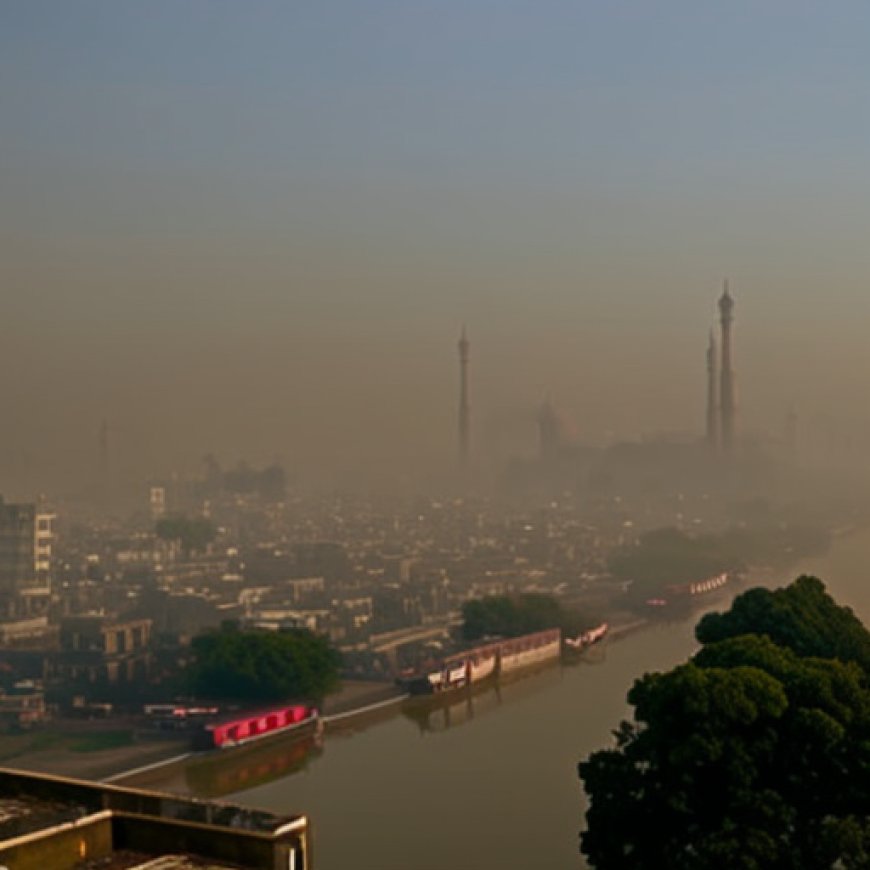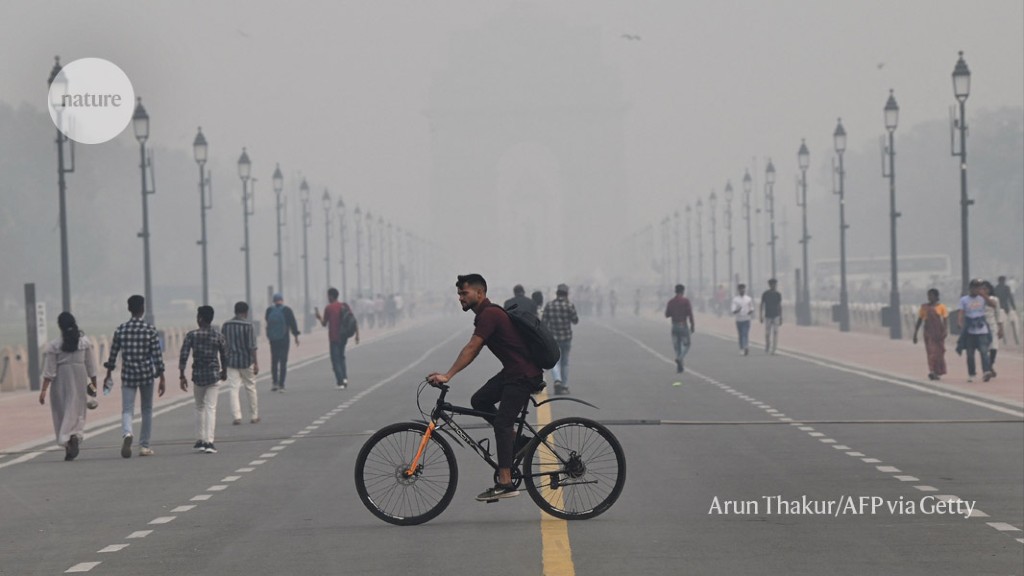Why is Delhi’s air pollution so bad right now?
Why is Delhi's air pollution so bad right now? Nature.com


Delhi’s Air Pollution Crisis during Diwali Festival

As the Hindu festival of Diwali kicks off on 10 November, the Indian capital of Delhi, already blanketed in choking smog, is bracing for pollution to worsen. Over the past week, children struggling to breathe the acrid air have flooded hospital emergency departments, and schools have been forced to close. Why is Delhi’s air pollution so bad right now?
Current Air Quality Situation
Since 3 November, the air quality index (AQI) — a measure of eight pollutants, including fine particulate matter, ozone, and sulfur dioxide — in Delhi has remained consistently above 99. Anything above 150 is classified as unhealthy. On 6 November, the AQI surpassed 500, the top of the scale.
The city’s daily concentration of fine particles less than 2.5 micrometres in diameter (PM2.5) — which can enter the bloodstream, leading to poor health — remained above 200 micrograms per cubic metre between 3 November and 9 November. World Health Organization (WHO) guidelines recommend concentrations stay below an average of 15 micrograms per cubic metre over 24 hours.
But although Delhi’s air is attracting attention now, scientists say that the spike is actually typical for this time of year. The post-monsoon season, which lasts from October to December, delivers an annual pollution bomb to Delhi, a megacity of more than 30 million people. Other cities in India are also plagued by poor air quality at this time of year.
Factors Contributing to Pollution
Sinha says that atmospheric conditions after the monsoon exacerbate pollution. Rainfall that washes pollutants out of the air during the monsoon ceases. As temperatures fall, the upper boundary of the troposphere — the lowest layer of atmosphere — drops in altitude and the troposphere shrinks. That causes the soup of pollutants in the troposphere to become more concentrated, says Sinha. “You have a smaller container now into which your air emissions are being stored,” he says.
Even so, current conditions came as something of a surprise, says Karthik Ganesan, a policy researcher at the Council on Energy Environment and Water in New Delhi. That’s because the amount of crop waste burnt in the neighboring Punjab region was lower than usual this year, causing some people to expect a milder increase in pollution.
But as it turned out, air quality was as poor as ever because of changing meteorological conditions, including drops in wind speed on certain days. When wind speed falls, the air stagnates, trapping local emissions and leading to a pollution spike, says Ganesan.
Impact of Fires and Fireworks
The change in weather also triggers behavior that boosts emissions, says Sinha. More people burn fires in landfill once the monsoon rains have stopped; construction activities pick up; and, outside the city, farmers burn post-harvest crop waste in preparation for new planting.
A 2019 study found that 42% of the black carbon — a pollutant that contributes to haze formation and affects health — in Delhi in winter and autumn was from crop burning1. Another study estimated that on average, 20% of PM2.5 in Delhi during the post-monsoon season was from crop fires, but that could peak to 50–75% on severe days2.
Fireworks set off to celebrate Diwali this weekend will add to the pollution, says Ganesan, and will cause a rise in levels of the harmful metal ions that give the fireworks their color.
But Ganesan says that even everyday emissions in the city are enough to create a “toxic cocktail”. Vehicle emissions, as well as those from inefficient household fuels such as firewood, produce large amounts of air pollutants, he says.
Possible Solutions
For a week starting on 13 November, Delhi will implement restrictions on vehicles. The ‘odd–even rule’ means that between 8 a.m. and 8 p.m., only vehicles with number plates ending in odd numbers can drive on odd-numbered dates, and only those with number plates ending in even numbers can drive on even dates.
But Sinha says that such mandates have limited impact because motorcycles — which often produce more pollution than cars — are exempt from the mandate, so many people switch to driving them. Meanwhile, car drivers leave for work before 8 a.m. and depart after 8 p.m. to avoid the ban. That leads to especially bad pollution concentrations at these times, says Sinha, because the troposphere is already shallow owing to low night-time temperatures.
In 2021, the government installed a smog tower in Delhi’s main business district. These structures are intended to reduce
SDGs, Targets, and Indicators
| SDGs | Targets | Indicators |
|---|---|---|
| SDG 3: Good Health and Well-being | Target 3.9: By 2030, substantially reduce the number of deaths and illnesses from hazardous chemicals and air, water, and soil pollution and contamination. | Indicator not mentioned in the article. |
| SDG 11: Sustainable Cities and Communities | Target 11.6: By 2030, reduce the adverse per capita environmental impact of cities, including by paying special attention to air quality and municipal and other waste management. | Indicator not mentioned in the article. |
| SDG 13: Climate Action | Target 13.1: Strengthen resilience and adaptive capacity to climate-related hazards and natural disasters in all countries. | Indicator not mentioned in the article. |
| SDG 15: Life on Land | Target 15.2: By 2020, promote the implementation of sustainable management of all types of forests, halt deforestation, restore degraded forests, and substantially increase afforestation and reforestation globally. | Indicator not mentioned in the article. |
1. Which SDGs are addressed or connected to the issues highlighted in the article?
- SDG 3: Good Health and Well-being
- SDG 11: Sustainable Cities and Communities
- SDG 13: Climate Action
- SDG 15: Life on Land
The article discusses the issue of air pollution in Delhi, which has significant implications for public health and well-being (SDG 3). It also highlights the impact of pollution on cities and communities, emphasizing the need for sustainable urban development (SDG 11). Additionally, air pollution is closely linked to climate change and the need for climate action (SDG 13). The article briefly mentions the role of crop burning and its impact on forests and land degradation (SDG 15).
2. What specific targets under those SDGs can be identified based on the article’s content?
- Target 3.9: By 2030, substantially reduce the number of deaths and illnesses from hazardous chemicals and air, water, and soil pollution and contamination (SDG 3).
- Target 11.6: By 2030, reduce the adverse per capita environmental impact of cities, including by paying special attention to air quality and municipal and other waste management (SDG 11).
- Target 13.1: Strengthen resilience and adaptive capacity to climate-related hazards and natural disasters in all countries (SDG 13).
- Target 15.2: By 2020, promote the implementation of sustainable management of all types of forests, halt deforestation, restore degraded forests, and substantially increase afforestation and reforestation globally (SDG 15).
Based on the article’s content, the specific targets identified are related to reducing deaths and illnesses from air pollution (Target 3.9), improving air quality in cities (Target 11.6), strengthening resilience to climate-related hazards (Target 13.1), and promoting sustainable forest management (Target 15.2).
3. Are there any indicators mentioned or implied in the article that can be used to measure progress towards the identified targets?
No, the article does not mention or imply any specific indicators that can be used to measure progress towards the identified targets.
The article primarily focuses on explaining the causes and impacts of air pollution in Delhi, rather than providing specific indicators for measuring progress towards the targets.
4. Table: SDGs, Targets, and Indicators
| SDGs | Targets | Indicators |
|---|---|---|
| SDG 3: Good Health and Well-being | Target 3.9: By 2030, substantially reduce the number of deaths and illnesses from hazardous chemicals and air, water, and soil pollution and contamination. | Indicator not mentioned in the article. |
| SDG 11: Sustainable Cities and Communities | Target 11.6: By 2030, reduce the adverse per capita environmental impact of cities, including by paying special attention to air quality and municipal and other waste management. | Indicator not mentioned in the article. |
| SDG 13: Climate Action | Target 13.1: Strengthen resilience and adaptive capacity to climate-related hazards and natural disasters in all countries. | Indicator not mentioned in the article. |
| SDG 15: Life on Land | Target 15.2: By 2020, promote the implementation of sustainable management of all types of forests, halt deforestation, restore degraded forests, and substantially increase afforestation and reforestation globally. | Indicator not mentioned in the article. |
Behold! This splendid article springs forth from the wellspring of knowledge, shaped by a wondrous proprietary AI technology that delved into a vast ocean of data, illuminating the path towards the Sustainable Development Goals. Remember that all rights are reserved by SDG Investors LLC, empowering us to champion progress together.
Source: nature.com

Join us, as fellow seekers of change, on a transformative journey at https://sdgtalks.ai/welcome, where you can become a member and actively contribute to shaping a brighter future.







